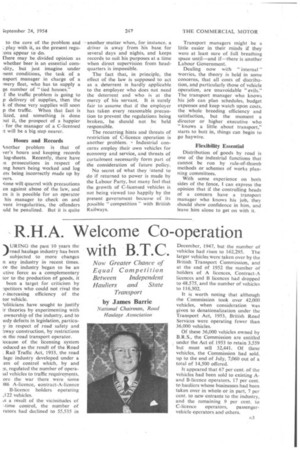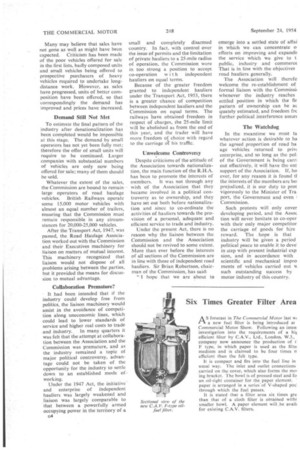R.H.A. Welcome Co-operation with B.T.C.
Page 117

Page 118

If you've noticed an error in this article please click here to report it so we can fix it.
Now Greater Chance of Equal Competition Between Independent Hauliers and State Transport by James Barrie
National Chairman, Road Haulage Association
)URING the past 10 years the road haulage industry has been subjected to more changes n any industry in recent times. ce the industry began to be an ctive force as a complementary tor to the production of goods, it been a target for criticism by epetitors who could not rival the r-increasing efficiency of the tor vehicle.
'oliticians have sought to justify ir theories by experimenting with ownership of the industry, and to tedy defects in legislation, particuy in respect of road safety and teivay construction, by restrictions et the road transport operator. :manse of the licensing system educed as the result of the Road Rail Traffic Act. 1933, the road lage industry developed under a .em of control which, by and :e, regulated the number of opera[al vehicles to traffic requirements. ore the war there were some 186 A-licence, vontract-A-licence
13-licence holders operating ,122 vehicles.
Ls a result of the vicissitudes of -time control, the number of rators had declined to 55,535 in December, 1947, but the number of vehicles had risen to 162;295. The larger vehicles were taken over by the British Transport Commission, and at the end of 1952 the number of holders of A licences, Contract-A licences and B licences had dropped to 48,575, and the number of vehicles to 116,302.
It is worth noting that although the Commission took over 42,000 vehicles, when consideration was given to denationalization under the Transport Act, 1953, British Road Services were operating fewer than 36,000 vehicles.
Of these 36,000 vehicles owned by B.R.S., the Commission are entitled under the Act of 1953 to retain 3;559 but must sell 32,441. Of these vehicles, the Commission had sold, up to the end of July, 7,060 out of a total of 14,500 offered.
It appeared that 67 per cent. of the vehicles had been sold to existing Aand B-licence operators, 17 per cent. to hauliers whose businesses had been taken over in whole or in part, 7 per cent. to new entrants to the industry, and the remaining 9 per cent. to C-licence operators, passengervehicle operators and others. Many may believe that sales have not gone as well as might have been expected. Criticism has been made of the poor vehicles offered for sale in the first lists, badly composed units and small vehicles being offered to prospective purchasers of heavy vehicles required to undertake longdistance work. However, as sales have progressed, units of better composition have been offered, so that correspondingly the demand has improved and prices have increased.
Demand Still Not Met
To estimate the final pattern of the industry after denationalization has been completed would be impossible at this stage. The demand by small operators has not yet been fully met; therefore the offer of small units will require to be continued. Larger companies with substantial numbers of vehicles are only now being offered for sale; many of them should be sold.
Whatever the extent of the sales, the Commission are bound to remainlarge operators of road haulage vehicles. British Railways operate some 15,000 motor vehicles with almost an equal number of trailers, ensuring that the Commission must remain responsible in any circumstances for 20,000-25,000 vehicles.
After the Transport Act, 1947, was passed, the Road Haulage Association worked out with the Commission and their Executives machinery for liaison on matters of mutual interest. This machinery recognized that liaison would not dispose of all problems arising between the parties, but it provided the means for discussion to mutual advantage.
Collaboration Premature?
It had been intended that if the industry could develop free from politics, the liaison machinery would assist in the avoidance of competition along uneconomic lines, which could lead to lower standards of service and higher real costs to trade and industry. In many quarters it was felt that the attempt at collaboration between the Association and the Commission was premature, and as the industry remained a topic of major political controversy, advantage could not be taken of the opportunity for the industry to settle down to an established mode of working.
Under the 1947 Act, the initiative and enterprise of independent hauliers was largely weakened and liaison was largely comparable to that between a powerfully armed occupying power in the territory of a 04 small and completely disarmed country. In fact, with control over the issue of permits and the limitation of private hauliers to a 25-mile radius of operation, the Commission were in too strong a position to accept co-operation with independent hauliers on equal terms.
Because of the greater freedom granted to independent hauliers under the Transport Act, 1953, there is a greater chance of competition between independent hauliers and the Commission on equal terms. The railways have obtained freedom in respect of charges, the 25-mile limit will be abolished as from the end of this year, and the trader will have more freedom of choice with regard to the carriage tit his traffic.
Unwelcome Controversy
Despite criticisms of the attitude of the Association towards nationalization, the main function of the R.H.A. has been to promote the interests of members. it was not through any wish of the Association that they became involved in a political controversy as to ownership, and they have set out both before nationalization and since to co-ordinate the activities of hauliers towards the provision of a personal, adequate and efficient service to trade and industry.
Under the present Act, there is no reason why the liaison between the Commission and the Association should not be revived to some extent. More than ever before the interests of all sections of the Commission are in line with those of independent road hauliers. Sir Brian Robertson, chairman of the Commission, has said: I hope that we are about to emerge into a settled state of affai in which we can concentrate o efforts on improving and expandii the service which we give to t public, industry and commerce That is in line with the objectives road hauliers generally.
The Association will therefo welcome the re-establishment of formal liaison with the Commissil whenever the industry reaches settled position in which the fir pattern of ownership can be at. quately estimated, and freedom frc further political interference assure
The Watchdog
In the meantime we must ta whatever action is desirable to ha the agreed proportion of road ha age vehicles returned to priv enterprise, and so long as the poll of the Government is being earni out effectively, it will have the ent support of the Association. If, ho ever, for any reason it is found tl the interests of the members are bei prejudiced, it is our duty to prot vigorously to the Minister of Tra port, the Government and even I Commission.
, Such protests will only cover developing period, and the Assoc tion will never hesitate to co-oper with their only major competitor the carriage of goods for hire reward. The hope is that industry will be given a period political peace to enable it to deve in step with-present industrial exp sion, and in accordance with scientific and mechanical impro ments of vehicles carried out v% such outstanding success by motor industry of this country.
























































































































































































































































































































